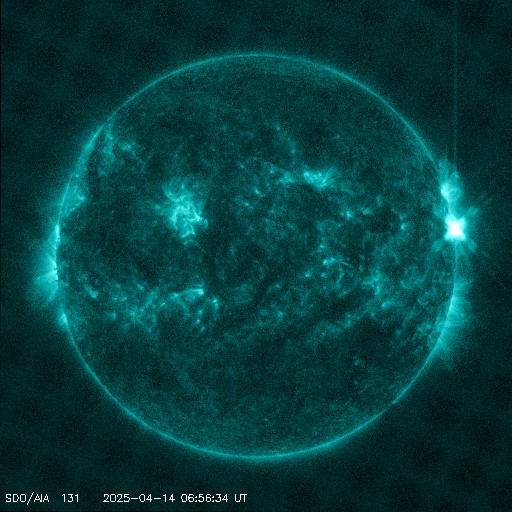Viewing archive of Wednesday, 19 June 2002
Solar activity report
Any mentioned solar flare in this report has a scaling factor applied by the Space Weather Prediction Center (SWPC). Because of the SWPC scaling factor, solar flares are reported as 42% smaller than for the science quality data. The scaling factor has been removed from our archived solar flare data to reflect the true physical units.
Report of Solar-Geophysical Activity 2002 Jun 19 2200 UTCPrepared by the NOAA © SWPC and processed by SpaceWeatherLive.com
Joint USAF/NOAA Report of Solar and Geophysical Activity
SDF Number 170 Issued at 2200Z on 19 Jun 2002IA. Analysis of Solar Active Regions and Activity from 18-2100Z to 19-2100Z
Solar activity has been low. A C5 event occurred at
19/1015 UTC. The LASCO/EIT imagery suggest the source of the event
to be Region 9991 (S22W85).
IB. Solar Activity Forecast
Solar activity is expected to be very
low to low.
IIA. Geophysical Activity Summary 18-2100Z to 19-2100Z
The geomagnetic field has been quiet to active conditions. Minor
storm conditions were observed at high latitudes. This activity is
attributed to a well positioned coronal hole.
IIB. Geophysical Activity Forecast
The geomagnetic field is
expected to be quiet to unsettled. Isolated active conditions are
possible for June 20 with the coronal hole passage.
III. Event Probabilities 20 Jun to 22 Jun
| Class M | 25% | 25% | 25% |
| Class X | 01% | 01% | 01% |
| Proton | 01% | 01% | 01% |
| PCAF | green | ||
IV. Penticton 10.7 cm Flux
Observed 19 Jun 146 Predicted 20 Jun-22 Jun 150/150/155 90 Day Mean 19 Jun 177
V. Geomagnetic A Indices
Observed Afr/Ap 18 Jun 008/011 Estimated Afr/Ap 19 Jun 012/016 Predicted Afr/Ap 20 Jun-22 Jun 015/018-010/010-008/008
VI. Geomagnetic Activity Probabilities 20 Jun to 22 Jun
| A. Middle Latitudes | |||
|---|---|---|---|
| Active | 20% | 20% | 15% |
| Minor storm | 10% | 10% | 05% |
| Major-severe storm | 01% | 01% | 01% |
| B. High Latitudes | |||
|---|---|---|---|
| Active | 25% | 20% | 20% |
| Minor storm | 10% | 10% | 05% |
| Major-severe storm | 01% | 01% | 01% |
All times in UTC
Latest news
Latest forum messages
2025/04/12-13 Filament CMEs 2025/04/16 G2 Watch 58AR4062 12Incoming & Unnumbered Active Regions 1710AR 4062 1Ask your obscure/"stupid" space weather questions. 355
More topicsSupport SpaceWeatherLive.com!
A lot of people come to SpaceWeatherLive to follow the Sun's activity or if there is aurora to be seen, but with more traffic comes higher server costs. Consider a donation if you enjoy SpaceWeatherLive so we can keep the website online!

Latest alerts
10:39 UTC - Solar flare
Moderate M1.52 flare from sunspot region 4055
10:24 UTC - Radio Blackout
Minor R1 radio blackout in progress (≥M1 - current: M1.52)
Monday, 14 April 2025
23:15 UTC - Geomagnetic activity
Active geomagnetic conditions (Kp4) Threshold Reached: 23:01 UTC
07:09 UTC - Solar flare
Moderate M4.28 flare from sunspot region 4055
06:48 UTC - Radio Blackout
Minor R1 radio blackout in progress (≥M1 - current: M1.53)
Space weather facts
| Last X-flare | 2025/03/28 | X1.1 |
| Last M-flare | 2025/04/14 | M4.2 |
| Last geomagnetic storm | 2025/04/06 | Kp5 (G1) |
| Spotless days | |
|---|---|
| Last spotless day | 2022/06/08 |
| Monthly mean Sunspot Number | |
|---|---|
| March 2025 | 134.2 -20.4 |
| April 2025 | 128.8 -5.4 |
| Last 30 days | 129.1 -15.1 |





